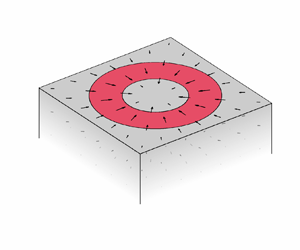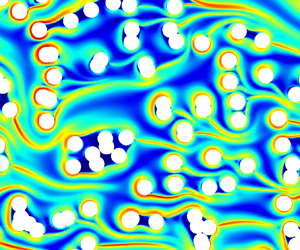Graphical abstract from Volk, R., Bourgoin, M., Bréhier, C. & Raynal, F. 2022 Phoresis in cellular flows: from enhanced dispersion to blockage. J. Fluid Mech. 948, A42. doi:10.1017/jfm.2022.730.
JFM Rapids
Added mass and damping of structures with periodic angular shape
-
- Published online by Cambridge University Press:
- 07 September 2022, R1
-
- Article
-
- You have access
- Open access
- HTML
- Export citation
Only two Betchov homogeneity constraints exist for isotropic turbulence
-
- Published online by Cambridge University Press:
- 20 September 2022, R2
-
- Article
-
- You have access
- Open access
- HTML
- Export citation
Focus on Fluids
Clogged corners
-
- Published online by Cambridge University Press:
- 02 September 2022, F1
-
- Article
-
- You have access
- HTML
- Export citation
JFM Papers
The role of monolayer viscosity in Langmuir film hole closure dynamics
-
- Published online by Cambridge University Press:
- 02 September 2022, A1
-
- Article
- Export citation
Birefringent strands drive the flow of viscoelastic fluids past obstacles
-
- Published online by Cambridge University Press:
- 02 September 2022, A2
-
- Article
-
- You have access
- Open access
- HTML
- Export citation
Unsteady motions in the turbulent separation bubble of a two-dimensional wing
-
- Published online by Cambridge University Press:
- 02 September 2022, A3
-
- Article
-
- You have access
- Open access
- HTML
- Export citation
Detecting Lagrangian coherent structures from sparse and noisy trajectory data
-
- Published online by Cambridge University Press:
- 06 September 2022, A4
-
- Article
- Export citation
Energy transfer mechanisms in adverse pressure gradient turbulent boundary layers: production and inter-component redistribution
-
- Published online by Cambridge University Press:
- 02 September 2022, A5
-
- Article
-
- You have access
- Open access
- HTML
- Export citation
Jetting and migration of a laser-induced cavitation bubble in a rectangular channel
-
- Published online by Cambridge University Press:
- 02 September 2022, A6
-
- Article
- Export citation
Large-scale influence of numerical noises as artificial stochastic disturbances on a sustained turbulence
-
- Published online by Cambridge University Press:
- 02 September 2022, A7
-
- Article
-
- You have access
- Open access
- HTML
- Export citation
Temperature-dependent wall slip of Newtonian lubricants
-
- Published online by Cambridge University Press:
- 05 September 2022, A8
-
- Article
-
- You have access
- Open access
- HTML
- Export citation
Efficient global resolvent analysis via the one-way Navier–Stokes equations
-
- Published online by Cambridge University Press:
- 06 September 2022, A9
-
- Article
-
- You have access
- Open access
- HTML
- Export citation
Structured input–output analysis of stably stratified plane Couette flow
-
- Published online by Cambridge University Press:
- 05 September 2022, A10
-
- Article
-
- You have access
- Open access
- HTML
- Export citation
Geometrical dependence of optimal bounds in Taylor–Couette flow
-
- Published online by Cambridge University Press:
- 05 September 2022, A11
-
- Article
-
- You have access
- Open access
- HTML
- Export citation
Two-way coupled turbulent particle-laden boundary layer combustion over a flat plate
-
- Published online by Cambridge University Press:
- 06 September 2022, A12
-
- Article
- Export citation
Forces governing the dynamics of liquid spreading in packed beds
-
- Published online by Cambridge University Press:
- 06 September 2022, A13
-
- Article
-
- You have access
- Open access
- HTML
- Export citation
Taylor–Culick retractions and the influence of the surroundings
-
- Published online by Cambridge University Press:
- 06 September 2022, A14
-
- Article
-
- You have access
- Open access
- HTML
- Export citation
Linear instabilities of pulsatile plane channel flow between compliant walls
-
- Published online by Cambridge University Press:
- 07 September 2022, A15
-
- Article
-
- You have access
- Open access
- HTML
- Export citation
Prandtl number effects on the hydrodynamic stability of compressible boundary layers: flow–thermodynamics interactions
-
- Published online by Cambridge University Press:
- 07 September 2022, A16
-
- Article
-
- You have access
- Open access
- HTML
- Export citation
Wave patterns of stationary gravity–capillary waves from a moving obstacle in a magnetic fluid
-
- Published online by Cambridge University Press:
- 07 September 2022, A17
-
- Article
- Export citation


















































































